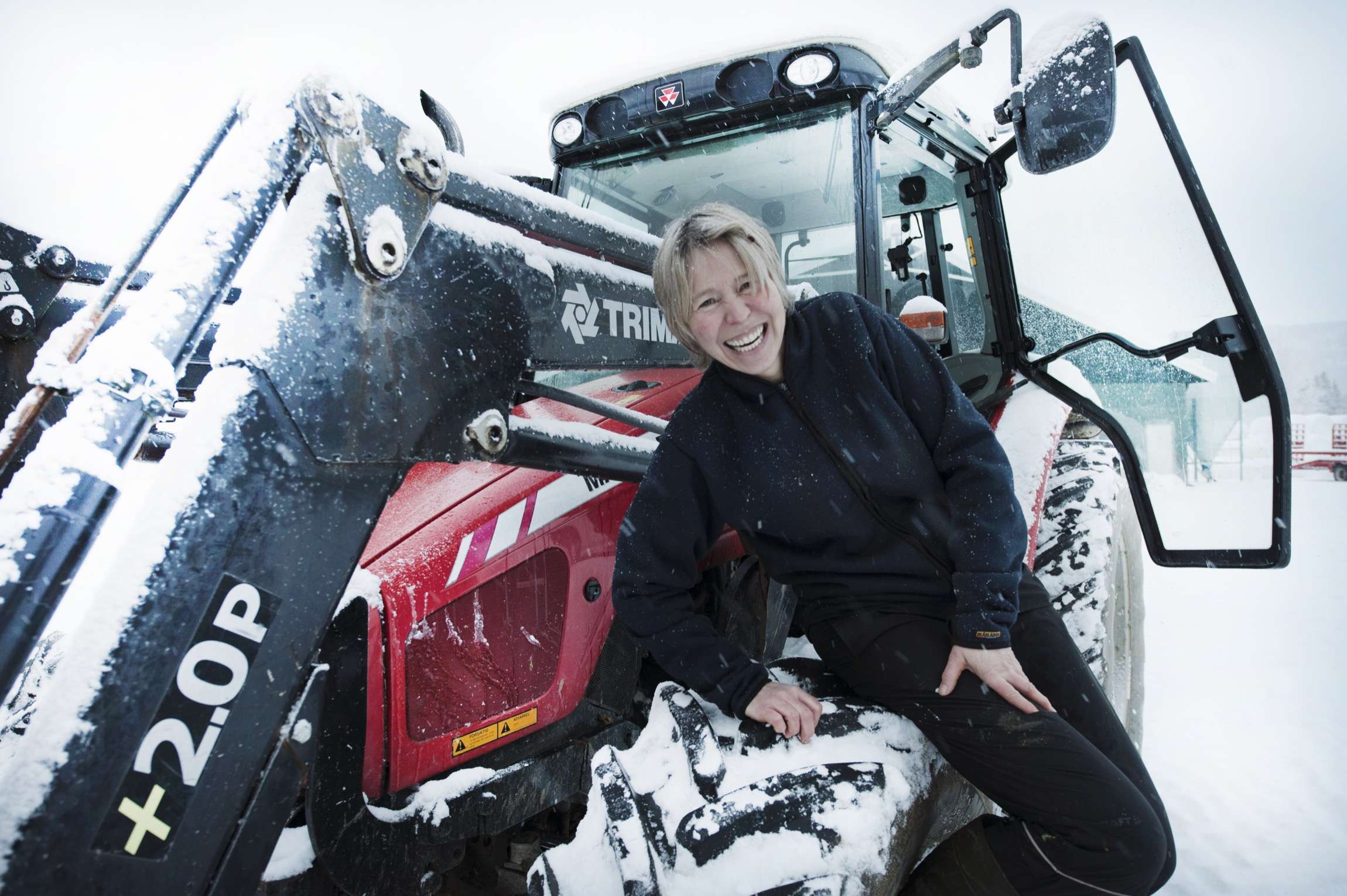
The woman who drives the tractor
Kristin Bygdås has been running her own farm at Bjerkmoen since 1999, but not everyone has had the same confidence in her. Five years ago, she wanted to upgrade her 90-horsepower tractor to a model with 200 horsepower.
“The salesmen laughed at me and insisted I make do with a 130-horsepower model. Clearly the salespeople thought women don’t understand tractors. Finally I had to get Roger, who is my life partner, to call around to get prices,” says Bygdås.
She is still confronted with such outdated attitudes. For instance when a trailer pulls into the farm to make a delivery and she sends Roger away to take care of other pressing tasks, the driver often stares at her astonishment. Then he usually asks whether he is supposed to unload it all by himself. When Bygdås climbs into the tractor, they look even more astonished.
“‘Do you know how to drive a tractor?’ they ask. But when I’m done, they’re impressed,” says Bygdås without a trace of irritation in her voice.
“I just laugh it off. When I encounter men with such attitudes, it gives me great satisfaction to impress them.”
Investments
Bygdås bought her farm in 1999. It was the house that caught her eye – an old house that needed a total restoration. With two little children and a third on the way, she wanted to move to the country. The seller wanted a buyer who would continue farming. So that’s how it came to be – even though her only experience with farming had been visiting the ancestral farm at Bleikvassli as a child.
She became a single mother when her children were quite young. So she had to run the farm by herself, and build things up alone. The house really hadn’t been upgraded since the 1920s.
“There was no electricity on the upper floor, and on the ground floor the floor had collapsed. We removed the baseboards and found ourselves staring straight down into the dirt. The house needed a total renovation! After everything that wasn’t up to par had been removed, only the shell was left,” says Bygdås.
While fixing up the house she met her present partner, Roger Jakobsen. He and his brother run Totalbygg, a building contractor with ten employees. Due to his severe allergies, Kristin involves him as little as possible in farm operations, but Roger plays a key role in the building projects.
“We spent ten years just on the house – our evenings, weekend and holidays. It was a monumental project. Roger is very finicky; he wants everything just so,” says the farmer.
The new barn was finished in 2011. In 2012, a storage building for farm machinery and tools was completed. At the end of that year, the Municipality of Korgen gave the farm its Award for Good Building Design.
“At one point, we were more than twelve million kroner in debt, and that wasn’t just due to our investments in buildings. We needed better equipment, including a more powerful tractor. And we expanded the farm from 50 to 200 acres. Summers here are brief and intense; that means you need reliable modern farm equipment to get the work done in a timely fashion
From dawn till dusk
Now it’s time to buy a new tractor again.
“In addition to a stronger tractor, I need a new harrow. Last year I bought a new sowing machine. By next year, both tractors will be paid off. We’ll put them to use as long as they’re running, but you have to be able to rely on your equipment. If your tractor breaks down during the harvest, you can’t just go out and rent one. It’s vital that everything runs perfectly at all times.”
Today they own 50 acres but rent an additional 150. Their farm complex has grown: the main house, the new barn and old barn, and two storage buildings for equipment. Now they’re adding a garage. The farm keeps 160 cattle at any one time, 55 of which are presently yearling calves. Every year the farm produces 450 tonnes of milk.
[caption id="attachment_9870" align="aligncenter" width="2300"]
 The farm requires long days in the barn.[/caption]
The farm requires long days in the barn.[/caption]No two days are alike. Typically, Bygdås gets up at seven and works in the barn more or less continuously until two in the afternoon. After a hot meal, she relaxes until five, before spending another couple of hours in the barn. At nine in the evening, she has to spend more time in the barn, and often does not finish until 11pm or so.
“On some days, I don’t even come back into the house before the evening meal. Many people say ‘You farmers have such a good life.’ They have no idea! Everything has to be kept clean and tidy, sometimes animals get sick, equipment must be maintained and repaired,” says Kirstin Bygdås.
“When someone says they want to become a farmer, I tell them that they really have to want this badly – and that they shouldn’t be alone. At least not if they intend to run a farm this size. True, I think we farmers are not so badly off, but it’s really hard work! By and large you can forget about free time and vacations. There’s hardly any of that, and you can never make firm plans.”








